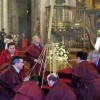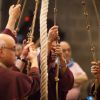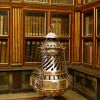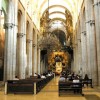- Accede I
- Regístrate I
- carrito
El Botafumeiro
El Botafumeiro es el enorme incensario usado desde la Edad Media como instrumento de purificación de una catedral en la que se apiñaban las multitudes. Hoy, 800 años después, sigue maravillando a los presentes cuando, tras la Comunión, suena el Himno del Apóstol en los órganos barrocos y este portento de la física comienza su asombroso recorrido pendular frente al altar mayor, para elevarse hasta casi rozar la bóveda del transepto.
Para ponerlo en movimiento se necesitan ocho hombres, llamados ‘tiraboleiros’, que lo traen de la Biblioteca cargado de incienso y carbón. Tras atarlo a la maroma que pende frente al altar mayor con tres gruesos nudos, lo bombean tirando con fuerza y precisión cuando se halla en el punto más bajo de su recorrido. De esta forma el Botafumeiro alcanza en sólo minuto y medio una velocidad de 68 kilómetros por hora y llega a formar un ángulo de 82 grados sobre la vertical, describiendo un arco de 65 metros de amplitud a lo largo del transepto. Son en total 17 ciclos de vaivén que dejan en los espectadores un recuerdo para toda la vida.
El Botafumeiro aparece ya en el Códice Calixtino, mencionado como Turibulum Magnum, por lo que el ritual data, cuando menos, del s. XII. Entonces era colgado de unas vigas de madera cruzadas en el cimborrio. El mecanismo actual, basado en el movimiento por poleas y la ley del péndulo, fue diseñado durante el Renacimiento por el maestro Celma.
En el s. XV, el rey Luis XI de Francia costeó la fabricación de un incensario de plata, pero en 1809 fue sustraído por las tropas napoleónicas acampadas en el claustro de la Catedral. En la actualidad existen dos incensarios, que se guardan en la Biblioteca Capitular: el más antiguo es de 1851 y fue creado por el orfebre José Losada. Está hecho de latón bañado en plata, mide 160 centímetros de altura y pesa alrededor de 62 kg cuando está vacío. El segundo es una réplica en plata del anterior, obsequio de los Alféreces Provisionales a la Catedral en 1971.
En su historia casi milenaria el Botafumeiro ha protagonizado pocos accidentes. El día del Apóstol de 1499, mientras honraban a la princesa Catalina de Aragón, el Botafumeiro salió volando y se estampó contra la puerta de Platerías. El segundo fallo tuvo lugar el 23 de mayo de 1622, cuando la cuerda se rompió y el Botafumeiro cayó contra el suelo. Y en el s. XX le rompió las costillas y la nariz a alguien que se acercó demasiado a admirar su asombroso mecanismo.



























